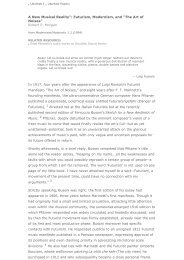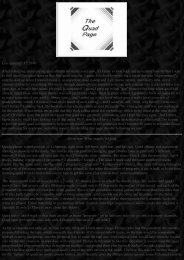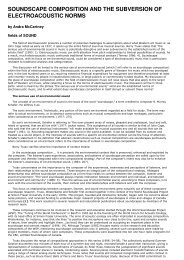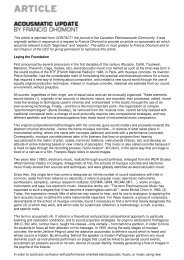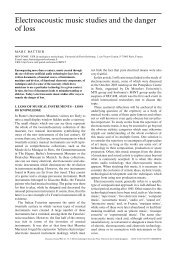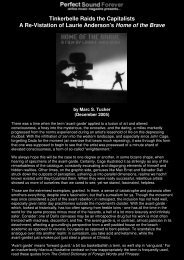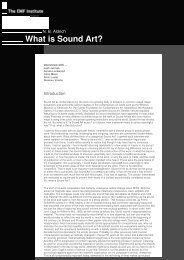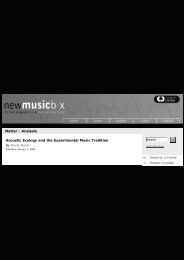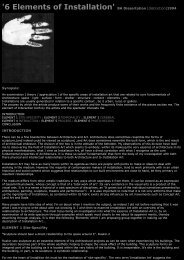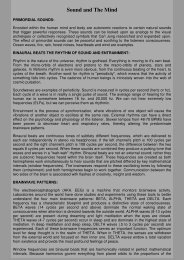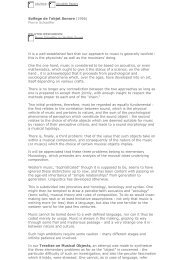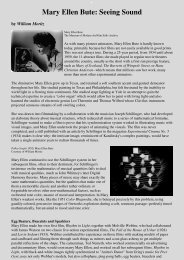Labelle-xxxx-Speaking Volumes.pdf - An International Archive of ...
Labelle-xxxx-Speaking Volumes.pdf - An International Archive of ...
Labelle-xxxx-Speaking Volumes.pdf - An International Archive of ...
- No tags were found...
You also want an ePaper? Increase the reach of your titles
YUMPU automatically turns print PDFs into web optimized ePapers that Google loves.
<strong>Speaking</strong> <strong>Volumes</strong>by Brandon LaBellealternate format- speaking volumes .<strong>pdf</strong>Taken one bright wintry day in the main town square in Copenhagen,during a random stroll, with various errands on my mind. Comingupon this group <strong>of</strong> friends, <strong>of</strong>travellers, I was moved bytheir joyful presence. Full <strong>of</strong>smiles and glee, the group -who I now glimpse as a kind<strong>of</strong> band, that is, players in agroup dynamic, on the roadand somehow <strong>of</strong>f it - seem tobe spending their time in themidst <strong>of</strong> celebration: Iimagine them on a privateadventure, journeyingoutside their frame <strong>of</strong>reference, on the edge, withwhimsy as their guide. <strong>An</strong>ordinary day made special.Coming upon this group,something else intervened, apresence difficult to locate inthe photograph, tounderscore, but which isreally at the fore. To drawattention to this buried presence, we can point to the ghetto blaster inthe lower corner <strong>of</strong> the image. The ghetto blaster hints at anotherlayer to this captured moment, and at the same time, it is really theheart <strong>of</strong> the image, because like any band the presence <strong>of</strong> musicoperates as life-blood, the goal and the directive, the unspoken oathand the elusive bond that comes to cohere into a collective voicegrantingthem the boldness to identify themselves as collective . Theband is "singular plural" if there ever was one. Singularity seeping intodisjointed and reworked bodies, where one limb is another's,choreographed into an elaborate movement turning matter intoenergy, motion into soundwave, which is always more than wave,more like force raised to the X-power <strong>of</strong> any given material. The bandis molecular, cohering through musical power. Glimpsing this band,this collective voice, on that sunny day I heard their music in the form<strong>of</strong> laughter and smiles jumping out <strong>of</strong> the photographic frame throughthe ghetto blaster and its volumetric persistence. Tuned to some popradio station and turned up loud, the blaster announces the group andtheir moment, as an amplification <strong>of</strong> their decision to spend day here,like this: the blaster is their musicality raising singular lives to thepower <strong>of</strong> collective adventure, twining individual breaths into sonicmovement.What brings me to this can be found in the image <strong>of</strong> the ghetto blasteritself, and the fact that it is turned away, pointing not toward the groupbut away to face the multitude there in the town square. The blaster istheir public advertisement. This fact casts the group as band, ascollective presence standing out, as a form <strong>of</strong> statement - they havesomething to share, and what they share can not be contained, itmust seep out, blast itself across the city. Like any band, they long forthe stage, because a stage speaks volumes. What they advertise,
what is blasted out, is nothing more than pure presence - the blasteraccentuates, by being overwhelmingly loud, their adventure and itsrealization.At the time, I simply took this photograph, in a friendly gesture, andkept walking, back through the square and onto my errands. But whenI turned, and began to walk, I kept listening, I kept hearing the band,their message carrying itself behind me, creeping up on me, andhanging on, catching hold <strong>of</strong> my heels like an audible vapour. Whilewalking I began to carry along their radiophonic ghost, keeping it alivein my ear, in my auditory thinking ( their smiling made me smile ...).Arriving at the other side <strong>of</strong> the square, I could still hear their music, atwhich point I decided to measure their performance, to locate thepoint where their volume would trail out into the city's sea <strong>of</strong> noise.This second photograph, here, was where I turned back to registerthe last molecular movement <strong>of</strong> their presence, where the trail <strong>of</strong> theirvoice faded out, and their music was submerged by the city.Located there, in the center <strong>of</strong> the image, near the distant trees full <strong>of</strong>yellowing leaves, the group sat and, at the same time, they were hereat this farthest point <strong>of</strong> amplified sound, <strong>of</strong> molecular movement, <strong>of</strong> airpressure turned radical expenditure. Between here and there, aspace opened up, something tangible yet difficult to locate, to sustainand build. A space nonetheless, one defined by a sudden movement,the appearance <strong>of</strong> a group <strong>of</strong> friends on an ordinary day taking hold <strong>of</strong>an unexpected stage. It is this space, between the farthest point awayand the closest instant <strong>of</strong> contact on which I want to dwell, for thissonic-space is where sound may occupy a given location, while in thesame movement, casting that space as energetic . To turn towardsound then is to recognize neither its source nor the final momentwhen it arrives at the ear, but the journey between, where city centrebecomes performance space, where ghetto blaster becomes soundinstallation, and where space becomes not an empty void but adynamic relation.Public AudioFollowing this dynamic relation, <strong>of</strong> sound and its public audibility, <strong>of</strong>amplification and its difficult sociality, leads to recognize on somelevel that sound is always a kind <strong>of</strong> intervention. It cuts into the givensituation, interrupting with its own sonorous pronouncement theexisting scene. Thus, we might hear in sound, and by extension thespaces <strong>of</strong> noise, a s<strong>of</strong>tening <strong>of</strong> the presumed dichotomy <strong>of</strong> order and
disorder, composition and its unravelling, sociality and its terms <strong>of</strong>commonality, for sound by nature is both an order and its ownupheaval. It points to a condition by which stability is built from aninternal incorporation <strong>of</strong> movement, eruption, and mutation. To alwaysintervene is to suggest that intervention is more a condition <strong>of</strong> movingthrough different states <strong>of</strong> energy or intensity. As Aden Evanssuggests, "sound is the difference <strong>of</strong> difference." In short, soundnever arrives on a scene devoid <strong>of</strong> an already existing dynamic, forsound is never static.To trace out sound and its process <strong>of</strong> intervention I want to look atsound art, and in particular, forms <strong>of</strong> sound art that move overtlytoward the public realm. To move from the space <strong>of</strong> the art gallery tothe realm <strong>of</strong> public space is immediately to conjure various tensions,histories, and possibilities. While it is apparent that art may find itsplace within public space, it is equally apparent that it does so with acertain amount <strong>of</strong> aggression (intentional or not). For we might ask:does the public realm need art?Various historical moments have seen art incorporated into the publicrealm as propaganda, as in the Russian Revolution <strong>of</strong> 1917, or as amode <strong>of</strong> public decoration or ornamentation, as seen in the Percentfor Art programs begun in the 1960s in the United States. Shadowingsuch legacies--from governmental propaganda to corporatedesign--we might point toward the general neo avant-garde ethos <strong>of</strong>the 1960s, which progressively sought the public throughperformance, installation, sound, and happening to overcome thelimitations <strong>of</strong> art's representational guise. To get at the heart <strong>of</strong> thereal was to also get at the heart <strong>of</strong> the public realm. From AlisonKnowles performing her Street Piece in Soho in 1962, which asks"Make something in the street and give it away", or her Color Musicseries (1963), which appropriates the street as a surface for printing,to Milan Knizak playing cello on his back in the streets <strong>of</strong> Prague(1962), which played havoc with class symbols espoused by theCommunist state, art was an aesthetic and performative surprisedisrupting the humdrum rhythms <strong>of</strong> public life. Art was a kind <strong>of</strong>un<strong>of</strong>ficial intrusion onto public spaceIn such public performances the use <strong>of</strong> sound can be heard asattraction and repulsion, whereby public appreciation is coupled withannoyance. Both <strong>of</strong> which may exist side by side in a state <strong>of</strong>compromise in front <strong>of</strong> the performing body (as in Knizak'sunabashedly poor cello playing), which is understood as a temporalpresence, that is, a momentary harangue onto the movements <strong>of</strong>daily life that may enrich or degrade (depending on your perspective)that life. Nevertheless, sound's presence within public space must beheard to raise the ante on art's public presentation. For as we know,sound carries a complex and dynamic punch that enthrals whilepotentially eliciting anger. It does so by always enacting a form <strong>of</strong>intrusion <strong>of</strong> a very complex nature, for sound invades through aseemingly subtle play while digging deep into the nerves. It may besaid to always occupy the border between pleasure and pain,performing across the spectrum <strong>of</strong> both by sending chills <strong>of</strong> bliss andshivers <strong>of</strong> misery down the spine. This may in turn be underscored asthe very core <strong>of</strong> sonorous potentiality - it may operate and define,through being both innocuous and totally invasive, the spectrum <strong>of</strong>human sensation and emotion. Such may lend to the understanding<strong>of</strong> musical power and energy, as being both individually and sociallyconstitutive <strong>of</strong> value. Music comes to define personal identity bystitching one into the emotional dynamics <strong>of</strong> sonorous intensity and itsorganization, while being granted meaning through the very sharing <strong>of</strong>
pleasure and/or pain within the social formation <strong>of</strong> either musical fansor their antithesis. From this perspective, music is a site <strong>of</strong> violencethat manifests in the ecstatic joys <strong>of</strong> personal celebration as well asthe cries <strong>of</strong> dislike.Sound too is generative <strong>of</strong> such opposed reactions. When channelledinto the production <strong>of</strong> public art it may be understood as a gift to thedynamics <strong>of</strong> audition, magnetized by its attempt to <strong>of</strong>ten makeapparent an aspect <strong>of</strong> the given environment or site. At timesadopting a relation to found phenomena, such as wind, light, or water,sound art in the public realm <strong>of</strong>ten seeks to further the potential <strong>of</strong>harmony by creating an audible cradle by which new forms <strong>of</strong>attention, perception, and care may be generated. Projects by suchartists as Hildegard Westerkamp, Max Eastley, and William LouisSørensen lend to this potential by allowing the sensitivities <strong>of</strong> the earto find its place.The installation began outside with three introductory panels introducing the subjects <strong>of</strong> listening andsoundscape. As visitors walked towards the Mati Ghar a natural cross-fade occurred from the sounds<strong>of</strong> New Delhi to a composed Indian soundscape broadcast from the loudspeakers on both sides <strong>of</strong> thepathway.Photo by Hildegard WesterkampLeading listener's through a sonic portrait <strong>of</strong> Vancouver,Westerkamp's soundwalks (initially produced in relation to herinvolvement with Vancouver Co-Operative Radio in the1970s)exemplify the artist's desire to make apparent the life <strong>of</strong> environments:compositionally, field recordings taken around the city are interwovenwith fragments <strong>of</strong> narrative about certain locations, leading the ear inand out <strong>of</strong> levels <strong>of</strong> perception and appreciation. Here the microphoneand recording device probe and uncover the life <strong>of</strong> the city in sonicdetail. As Westerkamp states, the functions <strong>of</strong> a soundwalk are"orientation, dialogue and composition."Westercamp's more recent Nada installation, researched andpresented in Delhi with Savinder <strong>An</strong>and, Mona Madan and VeenaSharma, comes to spatialize the soundwalk by structuring thelistening journey through a series <strong>of</strong> rooms and environments:incorporating sounds, textual information, spatial features, andambient details, the installation seeks to question our relation to theenvironment by provoking reflection on the auditory. How does soundmake an impression on our inner-most life, and how does it come tooccupy the borders between health and hazard, balance and itsantithesis? Whereas Westerkamp gains most <strong>of</strong> her sound materialsfrom audio recording, the artist Max Eastley has striven to draw uponthe direct movements <strong>of</strong> natural environments. From his Aeolian harp
and flute sculptures (which respond to wind) to his kinetic sculptures<strong>of</strong> stone, wood bars, and motors, sound occurs through a relation toimmediate surroundings, as a live unfolding. His outdoor project forSutton Edge in Yorkshire (1991) consisted <strong>of</strong> bow-like woodensculptures planted in the ground with string stretched taut forming adiamond-shape suspended against the wind. The extremely sensitivesculptures vibrated and flexed in response to the wind, creatingrhythmic oscillations that carried across the hills. To listen then is toappreciate and follow sound as a residue <strong>of</strong> a natural event, whereobject and phenomena intertwine to give voice to an acousticalpresence. The Danish artist William Sørensen's furthers suchconversations.The 4 flapping sound-instruments placed on the dike facing southwest in the direction <strong>of</strong> the wind.Photo by William Louis Sørensen.Sørensen's Landing Ground for Waders (1983) installed in WestJylland (Denmark) consists <strong>of</strong> a series <strong>of</strong> structures built from basicmaterials: wine bottles arranged in rows and tilted to face the wind, orwood structures draped in thick plastic that billowed out in response tothe wind, flapping and rippling with sound. The environment functionsas a player whose instruments reveal a buried music, a soundscapealways just out <strong>of</strong> reach, yet ever-present.These examples <strong>of</strong> outdoor, public sound art projects build areciprocal relation to the real: materials are aligned with foundphenomena, objects are constructed as instruments played by thenatural environment, and recordings lend to a sense <strong>of</strong> renewedorientation, hinting at overcoming any discrepancy between silenceand noise through an appreciation <strong>of</strong> the harmonious. Yet such worksarrive at harmony by surprising perception - on some level, the workengages the listener by producing something new. Whetherpreviously unheard or distant, proto-cosmic or geological, sound isculled from the environment and pulled into the centre <strong>of</strong> attention,attracting the ear by being all too "out <strong>of</strong> place".To enrich the experience <strong>of</strong> listening and an appreciation to theenvironment, on some level enacts a form <strong>of</strong> intrusion onto thatenvironment. Countering the intended coupling <strong>of</strong> listener andenvironment in harmonious caress, the potential that I want to focuson arrives through an unexpected relation to the harmonious, whichmay result in outcry rather than acceptance. To focus on this otherpart, the part that may go unheard, is to register sound's culturalweight by signifying not only through sensation or pure perception, butby a meaning found in the verbalization <strong>of</strong> abuse or appearance <strong>of</strong>vandalism.
One such example would be Bill Fontana's installation work, AerialWaters . Presented as part <strong>of</strong> Kunst in der Stadt festival in Bregenzon Lake Constanz in 1998, the installation was based on amplifying inreal-time sounds from the depths <strong>of</strong> the lake (using hydrophones) toseven bell towers located around the city. For Fontana, the belltowers <strong>of</strong>fered an architectural opportunity to disseminate theundulation <strong>of</strong> "water tonalities" across the city, creating reflections andechoes across the surfaces <strong>of</strong> the town, thereby instigating a"listening journey". During the first few days <strong>of</strong> the festival, Fontana'sinstallation was vandalized after causing a series <strong>of</strong> complaints fromlocal residents. After police set about investigating the crime, a localpriest confessed to have destroyed the speaker and receiver locatedat one <strong>of</strong> the bell towers "in a fit <strong>of</strong> rage."Such a radical reaction points to the dilemma public art in generalfaces, but which sound art seems to heighten. The seeming subtlety<strong>of</strong> amplifying "water tonalities" from bell towers for a period <strong>of</strong> time<strong>of</strong>fers up the environmental and aesthetical potential <strong>of</strong> discoveringanew one's location and the inherent musicality found there, while atthe same time running the risk <strong>of</strong> irritating local inhabitants with an alltoo present sonorous intrusion. Vandalism here may reveal to whatdegree sound, no matter how aesthetic, infringes upon the sense <strong>of</strong>self and its auditory constitution. What allows certain sounds to causepleasure and pain <strong>of</strong> course is at the heart <strong>of</strong> much sound art, whichsets out to instigate a total redrawing <strong>of</strong> one's listening exposure byexploring, composing, and amplifying alien sonics.Similar discussions on the issue <strong>of</strong> acoustical irritation took place inresponse to a work by artist John Wynne. The Sound <strong>of</strong> Sirens wasexhibited by Copenhagen's now closed Sound Gallery in 1997.Consisting <strong>of</strong> 25 speakers set within the ground <strong>of</strong> the city's mainsquare, the <strong>of</strong>ficially sanctioned Gallery operated through extremelyexposed and public circumstances by creating a potential sound field<strong>of</strong> 900m2.Copenhagen town square, 2005. Photo by Brandon LaBelle.Working solely with warning signals and alarms, Wynne's projectbecame a site for debate between aesthetic value and the rights topublic space, forcing sound and its presentation to become a civicand governmental issue. For what became immediately apparent wasthat positioning sound within the public realm brings to question theoccupation <strong>of</strong> that space. That Wynn e 's work was consequently shut
down by the City Council due to the fact that people were "confusedand frightened" by the work highlights the degree to which sound mayradically infringe upon public space, and challenge civic notions <strong>of</strong> anethics <strong>of</strong> display and the rights to occupation. Being positioned withinthe main square <strong>of</strong> the city, which is designated a site <strong>of</strong> gathering forpolitical, cultural, and local groups to give free expression to publicdebate, issues, and arguments, The Sound <strong>of</strong> Sirens remained anessentially distressing work. Claiming it art with aesthetic value wasnot enough to dissuade the work's closure.The director <strong>of</strong> the Sound Gallery, Michael Madsen, stated: "As I wasinterested in the public space as a site for the chance encounterbetween artistic intention and casual passers-by, I realized that theideal space for such a rendezvous would be the Copenhagen's TownHall Square, locus <strong>of</strong> Denmark and site for many important eventsand as such also an inner space <strong>of</strong> reference in every Dane." Builtinto the gallery was thus an interest in the idea <strong>of</strong> producing an"encounter," an encounter in conjunction with Madsen's furtherinterest in the "movement <strong>of</strong> sound":"I also realized that by hiding the speakers or putting them in unusualpositions, I could somehow detach the sound from its bearers andthereby enrich the listening experience. The ideal configurationemerged as a field <strong>of</strong> speakers creating an area around which thelistener could move freely."The question <strong>of</strong> "enriching" the listening experience is predicated onthe assumption that the public is at all interested in such experience.This is not to suggest that one should not develop such work, engagewith public space, and inaugurate new forms <strong>of</strong> artistic encounters,but rather that while we may concentrate on the physical andperceptual materiality <strong>of</strong> sound, it may in turn behove our auditorypursuits to appreciate and embrace sound's inherent ability to annoy,antagonize, and agitate. These qualities are part <strong>of</strong> what sound <strong>of</strong>fers.Thus, notions <strong>of</strong> "moving freely" are always countered by a work'sinherent abuse <strong>of</strong> such freedom - sound art not only incites thepleasures <strong>of</strong> auditory discovering, but the pain <strong>of</strong> having tocompromise in the face <strong>of</strong> its own public assumptions.These works bring to mind an understanding <strong>of</strong> social spacepredicated by the continual negotiation <strong>of</strong> difference rather than bysocial contract. Sound art in public could be said to enact suchnegotiation on the field <strong>of</strong> audition, fuelling the contestation <strong>of</strong>difference by making ambiguous the terms <strong>of</strong> commonality. For whileit may aim to direct attention to the given environment, either byharmonizing or altering, it does so by infusing the known with forms <strong>of</strong>amplification. Whether <strong>of</strong> natural phenomena or the associativeconnotations <strong>of</strong> signals sound art may bring forward things noteveryone wants to hear. Sound art performs according to a radicalambiguity that nonetheless juxtaposes or mixes, through an audibleoverlay, the intense specifics <strong>of</strong> place, bodies, and their continualintersection. For the 25,000 people who cross Copenhagen's townsquare daily, or the individual priest in Bregenz, such an intersectionbrought forward how sound art may be truly heard not only by thosewho respect its presence, but also by those who refuse to endure it.Value <strong>of</strong> interventionThe value <strong>of</strong> such work may reside partly in raising the stakes in howwe negotiate the intensities inherent to sound's presence in publicspace. For as I've suggested, sound on some level is always a form
<strong>of</strong> intervention through its ability to interrupt and thus mutate the givenfield <strong>of</strong> existing sound. In contrast to other media, and sensorialexperience, sound seems to intensify the level by which its publicpresence may spark disdain and annoyance, alongside pleasures. Tomake an addition to that field <strong>of</strong> sound is to play not only with thevolume and air pressure, but also people's nerves. Entering the publicrealm with sound art would seem to demand, as part <strong>of</strong> a work'sintention and scope, a self-conscious instrumentalizing <strong>of</strong> sound'sinherent force to intervene.As the artist Simon Leung has suggested, the very nature <strong>of</strong> being anindividual entails a level <strong>of</strong> intervention. Most exemplified throughspeech, Leung understands intervention first and foremost as anethical demand, whereby the voice announces the subject onto thefield <strong>of</strong> the social. To speak then is to intervene upon, through anappropriation <strong>of</strong> language, the existing scenario. Such speakingrequires both a belief in the possibility <strong>of</strong> speech itself - that the voicemay carry individual intention toward another - and a necessaryviolation <strong>of</strong> existing conditions, for speech cuts into the realm <strong>of</strong>conversation while contributing to its evolution. Thus, the ethics <strong>of</strong> thevoice requires an acceptance, on the part <strong>of</strong> the speaker and thelistener, <strong>of</strong> the very nature <strong>of</strong> an interventionist movement. To overlaythis sensitivity onto the realm <strong>of</strong> public art, and in particular sound artin public spaces, is to suggest that the one who makes and the onewho receives are bound to a conversation produced by the intensities<strong>of</strong> such ethics.



